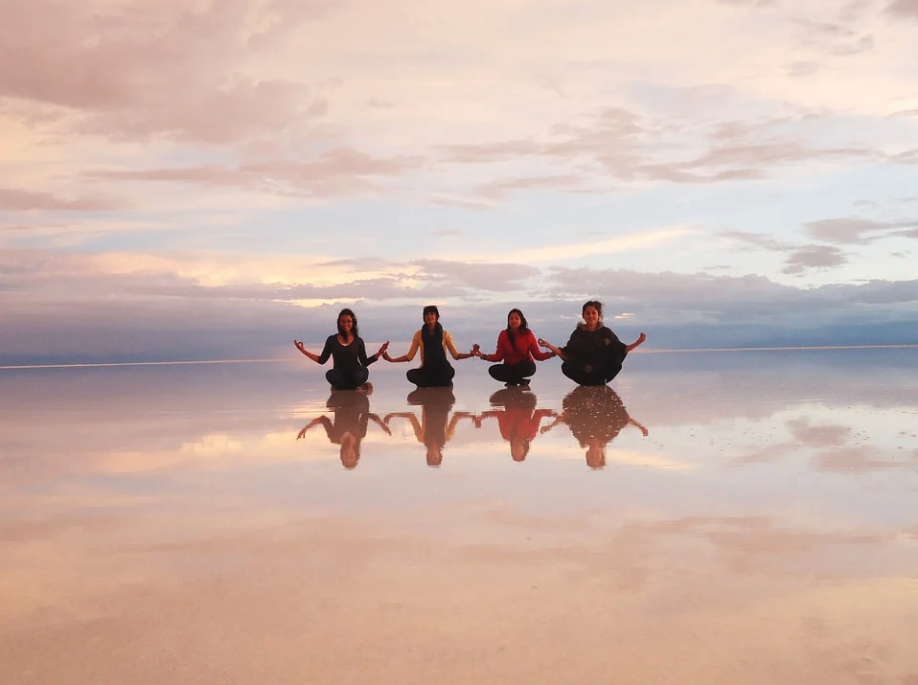
I have been meditating for over 20 years. I credit meditation for helping me through a lot in life. But it hasn’t always been easy.
In many ways, it’s like having a healthy diet. Or going to the gym or on runs. It is something I know is good for me, but it is also something that gets pushed to the side when life gets busy.
So how do I keep it up? And how can you start and maintain a regular meditation routine?
First, start small
A key to starting and maintaining many healthy habits is to start small. 5-minute meditations are fantastic. But how about 2-minute or 1-minute meditations? Also great.
Many teachers will start with guiding students through just a few breaths.
Breathe in deeply through the nose. Hold it for the count of 2. Breathe out slowly.
Just a few deep breaths in and out through the nose can trigger your resting, parasympathetic nervous system. This is the system in the body that tells us we’re safe. Our heart rate slows. Digestion increases. As our body becomes oxygenated, our mind gets not only calmer but clearer.
Just this bit of practice can make a difference that lasts well into your day. But regular practice will make this an easy go-to exercise when needed. Stressful meeting at the office? Take some deep breaths. Seeing terrible news on social media? Take some deep breaths. About to tackle a tough physical or mental challenge? Take some deep breaths.
Involve a friend
Next, get a friend involved. Nothing helps keep us on track like accountability. These days we all know someone who meditates or does yoga. Or we know someone who wants to start.
Getting them involved can create a virtuous cycle. You help encourage them when they need it. They help encourage you when you need it. Everyone benefits.
Meditation is so easy that it also becomes easy to put off. Having a friend to keep us accountable helps to ensure we keep up our practice. A friend can also help find new practices and techniques when our routine grows stale. And they can be someone to talk to when we’re having difficulties. Even if they are just starting out like us, they might have ideas for getting around obstacles. And sometimes just saying what is troubling us out loud can help us resolve it.
Set Goals
Getting a routine of 2 minutes a day for a week might sound easy at first. Try it. If you fall off schedule, start again. Maybe you can do this easily in week one. Maybe it takes 10 days or 20 before you get 7 consecutive days of meditation.
This is one example of goals you can set. You can create your own goals. The important thing is to set them. Write them down. Tell your friend. Then do it. There are 1440 minutes in a day. If we sleep for 8 hours, we have 960 minutes. Surely, we can set aside 2 or 5 for meditation.
Use positive rewards
Once you have that down, perhaps reward yourself. But then it’s on to 5 minutes a day. Once again, aim for 7 days in a row of meditation. Then try 10 minutes, and so on.
Don’t feel too bad when you miss a day. Change is difficult. Developing healthy habits is difficult. If it weren’t everyone would be healthy. And just look around. We’re not healthy. Our society needs some big help. So it’s okay if you slip back from time to time. And it’s amazing that you’re making progress.
For Buddhists and many other spiritual people, we are all fundamentally connected. The improvements we make in our life naturally and inevitably spread out into our world like ripples on a pond’s surface. Over time, our own calm and focus might bring a smile to a friend or coworker’s face. It might encourage them to make positive changes as well.
Find a teacher

One of the hardest steps for developing meditation can be finding a good teacher. A teacher is someone who has been doing this practice for a long time. They know the ins and outs. They have seen their own failures and have kept going. And they have worked with others on overcoming obstacles.
Everyone will have different ideas of what a teacher should look like. Perhaps you want certifications, like those given to teachers of Mindfulness Based Stress Reduction (MBSR). These take months of work and thousands of dollars to acquire. So people with them can be trusted to have put in effort.
Others will want a lineage or institutionally approved teacher. These teachers are often ordained priests or lamas or gurus. Likewise, such ordination processes often take years of dedicated study and practice. This too ensures the dedication of the person with the title.
Know that finding the right teacher might take time. Teachers are still ordinary people in most ways. It’s important to find someone you can connect with. I’ve had a number of teachers who I connected with deeply over the years. Each one offered new perspectives and new techniques for growth in my meditation. Some, like Sharon Salzberg or Roshi Joan Halifax, I’ve only been able to sit with in person once or twice at short retreats. Others, like the insight meditation teacher and psychologist Matthew Flickstein, I’ve been able to see several times over the years.
But it’s also important to have realistic notions. You probably shouldn’t wait to get lessons directly from the Dalai Lama, for instance. I’ve seen the Dalai Lama three times now. Twice in the US and once in Dharamsala, India. And, while amazing in many ways, the distance (physical and spiritual) between him and me made it hard to really take my meditation forward.
The exalted monk on the mountain-top might be a great ideal, but it’s also important to start where we are at. Some of the best meditation teachers I’ve had have been people relatively new to the practice, like me, but who had some special insights and ideas I could use in the moment.
Speaking of the moment. Here are a couple 2-minute meditations to get you started.
https://www.youtube.com/watch?v=ZJGgpfx01KE&ab_channel=JohnsHopkinsMedicine
https://www.youtube.com/watch?v=Jholcb8Gz0M&ab_channel=MindfulBreaks
 Justin Whitaker, Ph.D., holds a doctorate in Buddhist ethics from the University of London. He has given lectures, and taught Buddhist studies and Philosophy at Oxford University, the University of Hong Kong, the University of Montana, and at Antioch University’s intensive study-abroad program in India. He is a certified meditation teacher, a regular contributor to Patheos.com, and Senior Correspondent for Buddhistdoor Global. He lives in Missoula with his family.
Justin Whitaker, Ph.D., holds a doctorate in Buddhist ethics from the University of London. He has given lectures, and taught Buddhist studies and Philosophy at Oxford University, the University of Hong Kong, the University of Montana, and at Antioch University’s intensive study-abroad program in India. He is a certified meditation teacher, a regular contributor to Patheos.com, and Senior Correspondent for Buddhistdoor Global. He lives in Missoula with his family.
